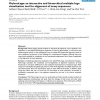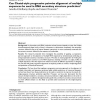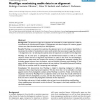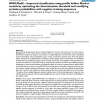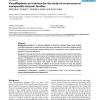BMCBI
2007
13 years 5 months ago
2007
Background: When aligning several hundreds or thousands of sequences, such as epidemic virus sequences or homologous/orthologous sequences of some big gene families, to reconstruc...
BMCBI
2010
13 years 5 months ago
2010
Background: Datasets generated on deep-sequencing platforms have been deposited in various public repositories such as the Gene Expression Omnibus (GEO), Sequence Read Archive (SR...
BMCBI
2007
13 years 5 months ago
2007
Background: In ribonucleic acid (RNA) molecules whose function depends on their final, folded three-dimensional shape (such as those in ribosomes or spliceosome complexes), the se...
BMCBI
2007
13 years 5 months ago
2007
Background: Metagenomic analyses of microbial communities that are comprehensive enough to provide multiple samples of most loci in the genomes of the dominant organism types will...
BMCBI
2010
13 years 5 months ago
2010
Background: Accurate classification into genotypes is critical in understanding evolution of divergent viruses. Here we report a new approach, MuLDAS, which classifies a query seq...
BMCBI
2007
13 years 5 months ago
2007
Background: In many contexts, researchers need specific primers for all sequences in a family such that each primer set amplifies only its target sequence and none of the others, ...
BMCBI
2007
13 years 5 months ago
2007
Background: The presence of gaps in an alignment of nucleotide or protein sequences is often an inconvenience for bioinformatical studies. In phylogenetic and other analyses, for ...
BMCBI
2007
13 years 5 months ago
2007
Background: Profile Hidden Markov Models (HMM) are statistical representations of protein families derived from patterns of sequence conservation in multiple alignments and have b...
BMCBI
2010
13 years 5 months ago
2010
Background: Most known eukaryotic genomes contain mobile copied elements called transposable elements. In some species, these elements account for the majority of the genome seque...
BMCBI
2008
13 years 5 months ago
2008
Background: Repbase is a reference database of eukaryotic repetitive DNA, which includes prototypic sequences of repeats and basic information described in annotations. Repbase al...
